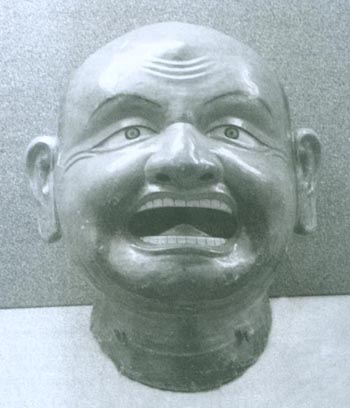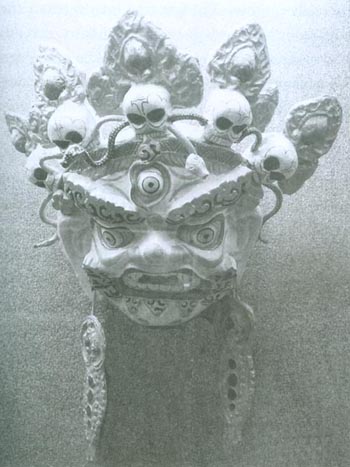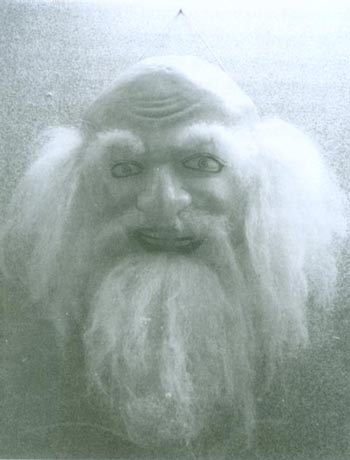The art of Tibetan masks forms an essential element of traditional Tibetan culture. The masks are famous for their unique style, diversity of shapes and characteristically simple, unsophisticated and primeval beauty. Tibetan masks are therefore an important area for research. This article intends to give a brief introduction to the masks in order to offer readers a basic overview of this art.
Ⅰ、The Origin and Development of Masks
1、The Origin of Masks
According to historical records, after the sixth century when the Tubo was a feudal kingdom based on slavery, Bonpo dances with totem animal masks and 〝the sound from hand drums〞were already performed and from these dances white goat masks are said to have originated. In the first half of the seventh century when Srong-btsan-sgam-po was in power, the Tibetan script and written laws were created and dances 〝with masks to act as lions, tigers, yaks and leopards〞appeared as a traditional program for grand ceremonies. These two examples illustrate that masks came into being as early as in the Tubo Kingdom.

A mask of the monk in 17th century
In the reign of Khri-srong-lde-btsan, Tubo culture developed rapidly and extensively. In 779, when the Grand Hall of the bSam-yas Monastery was completed, Khri-srong-Ide-btsan, Zhi-ba-vtsho (Santaraksita) and Guru Rin-po-che (Padmasambhava) held a consecration ceremony. The murals on the left and right walls vividly depict this grand occasion. On that day, the bustling bSam-yas Monastery was filled with a multitude of splendidly dressed people, dancing and singing. According to the records of A Feast for Wise Men (Chos-vbyung-mkhas-pavi-dgav-ston), at the feast held on this ceremony, Khri-srong-Ide-btsan sat on a gold seat with his five consorts in full costume. Umbrellas, columns and banners almost blotted out the midday sun. The music from big cymbals was like bird's singing. All the young men and women wore beautiful clothes as they beat drums with yak tails while dancing and singing. Some of them wore masks and pretended to be young lions. Elaborately costumed dances played games or walked around with drums in hand. During the period, a Tibetan white mask opera-popular in Lho-kha areas and Lhasa was performed and was the origin of all subsequent Tibetan operas. According to Tibetan manuscripts and the consensus of experts, the origin of Tibetan mask art is closely related to the creation of Tibetan primitive Bonism, laws and Tibetan script as well as to the bSam-yas Monastery, the first in the history of Tibet. The history of this art form can be traced back before the sixth century.
2、The Natural Conditions for the Formation of Masks and the Development of This Art.

A mask of the guardian deity
Apart from longstanding view that〝a red face is one of basic characteristics of Tibetans〞, a historical record says that〝(Tibetans) liked to paint their face red〝.[2] The troops of the Tubo Kingdom painted their faces with animal's blood in order to scare their enemies and boost their own morale. This is the preliminary form of masks. According to archeological material and manuscripts, Tibetan's custom of painting the face with make-up can be traced back to the Neolithic Age or earlier. This customs is not only found in the Ka-rab Culture, but also and to a greater extent in the Ma Jia Yao, Ban Shan, and Ma Ya Cultures, all of which are in Gansu and Qinghai provinces and have development from the Miao Di Gou Culture. For example, a colored pottery kettle in the shape of a naked human being was found at Liu Ping Tai in Liu Wan, Le Du of Qinghai Province and on the neck of the kettle is a face with a black line painted along either side of the nose and mouth. The second example is the tri-headed statues excavated from Guanghe in Gansu Province. They have designs similar to the skin to cats, tigers or leopards painted on their faces, necks and shoulders. According to The Book of the Sui, in the Dongnü Tribe (the present Chab-mdo area), 〝…men and women painted their faces with colors, with were changed several time a day〞[3]. This demonstrates that when Tibet was a clan society, painting faces was quite important in Tibetan's daily life. When Princess Wen Cheng came to Tibet, she should not get used to this custom and "was disgusted with Tibetans' painted faces, so banned it in Tibet".[4] As the ancient custom of painting faces was banned, dances with marks, which had previously developed along with the former, had much more space to develop and so Tibetans focused their respect and love for traditional on the art of masks. Therefore, we may conclude that the custom of painting faces in not only the origin of the mask art, but also tremendously promoted the latter's development during its longstanding use by Tibetans.
Tibetan have lived on hunting and grazing since ancient times and thus formed a close relationship with animals such as horses, yaks, sheep, tigers, lions and monkeys. Because of the influence of these animals over their lives and their love for them, it was natural for Tibetans to worship animal skeletons. Moreover ancient Tibetan used animal skin and fur as charms and ornaments, as it shown by Tibetan murals. In addition, many Tibetans rock paintings depict the activities of hunting and grazing, in which people wear feathers on their heads and hang on ornaments on their bodies. Some of the figures look like witches and some parts of the painting seem to be depicting a battle. Thus we may conclude that masks used in ancient times were probably made of animal skin and fur.

A mask of Devas of ling life
